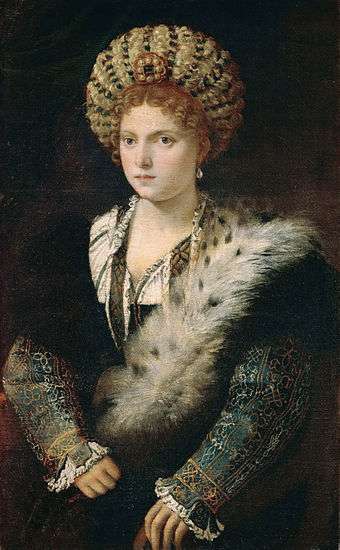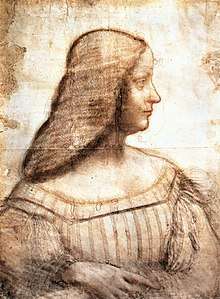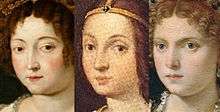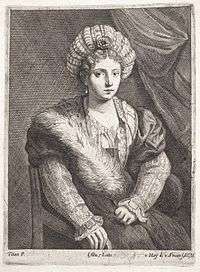Portrait of Isabella d'Este (Titian)
Portrait of Isabella d'Este (or Isabella in Black) is an oil-on-canvas painting by the Italian painter Titian, completed between 1534 and 1536. It shows the Marquess of Mantua, Isabella d'Este, daughter of Ercole I d'Este, Duke of Ferrara, and Eleanor of Naples with an ermine zibellino draped over her shoulder.

Although Titian depicts her as a young woman, she was around 62 at the time [1] Isabella was socially ambitious and aware of the effect a painting by a renowned artists might have on her reputation and prestige - she also commissioned portraits by Leonardo da Vinci and Andrea Mantegna.[2]
It is one of two portraits Titian painted of her; Isabella in Red (or Aged Isabella) of 1529 is known only through a Peter Paul Rubens copy. It showed a more aged and matronly Isabella, but she was so displeased with the picture that she asked for a second idealised portrait, showing how she thought she looked forty years earlier.[3] Art historian Lionel Cust mentions that Isabella's fame and renown was not due to "beauty, but to intellect and character".[4] Fred Kleiner wrote that the work is a "distinctive portrayal of his poised and self-assured patron that owes little to its model".[5] It is today in the Kunsthistorisches Museum, Vienna.
Background
Isabella was portrayed a number times in her youth. She was betrothed to Francesco Gonzaga in 1480 when she was 6; they married when she was 16. She was painted by Cosme Tura as a child and on a number of occasions around the time of her wedding, a period during which she was honoured by the striking of a commemorative medal.[4] She was critical of a portrait by Andrea Mantegna completed after 1493, and by the 1510s became very weary of representations of her likeness. She seems to have feared the effects of age, and a short woman, worried she was getting stout.[6]

She retained very strong ideas for the rest of her life as to how she should be portrayed. From the 1520s she asked that she be painted from written descriptions - with the rationale that words captured more closely a person's essence than life sittings. This was convenient for Titian, who was much sought after as a portraitist, disliked travel, and anyway prided himself on the fact that he could capture a likeness from written description. Nonetheless, she rejected his first portrait, the now lost Isabella in red of 1529, feeling it did not flatter, and five years later asked that he paint a second. The complaints registered of the first painting indicate that the last thing sought by the patron was anything approaching a likeness. There was displeasure with the portrayal of her nose, posture, costume, facial expression, and the highlighting of her squint.[7]

Isabella sought to influence Titian by sending him a 1511 portrait painted by Francesco Francia, which shows her as a young woman and highlighted her girlish beauty.[8] This work was in turn based on an even earlier portrait (probably Lorenzo Costa or Leonardo's drawing) and her half-sister Lucrezia d'Este-Bentivoglio's oral description.[1][9] Francia was given the opportunity to travel to Mantua so that Isabella could sit, but he declined, believing that he would paint better from the drawing and written description. This was convenient for Isabella, who wrote to him that he had "indeed made us far more beautiful by your art than nature ever made us". Yet she had later doubts that this work was how she was to be definitely seen and remembered by; she believed it made her eyes look "too black" and that the shadows were too heavy, and asked that both be lightened.[10][11]
Titian was assisted by Gian Giorgio Trissino's written description of Isabella. She was so pleased with Titian's second depiction that she wrote, "The portrait by Titian's hand is of such a pleasing type that we doubt that we were ever, at the age he represents, of such beauty that is contained in it."[12]
Others were not so impressed by the obvious deceit of the final Isabella in Black. Contemporary writer and satirist Pietro Aretino described the final painting as "dishonestly ugly" and a "supremely dishonestly embellished" that displayed undeserved "white teeth" and "ivory eyelashes".[3] Art historians examining the work tend to focus on her vanity, while largely acknowledging that court women of the time were on public display and expected to be physically pleasing and personally charming while at the same time showing signs of modesty and chastity.[13] This was not the first time that Titian had flattered a sitter with a rejuvenated, retrospective, or idealised image; his portrait of Philip II of Spain shows the king, who was puny in life, as a military hero bathed by light to grant both an aura to the hero and an actual halo.[1]
Identity of sitter

Portrait of Isabella d'Este is described as a portrait of the Queen of Cyprus (inventory list of Archduke Leopold Wilhelm of Austria in 1659) and was identified by an inscription on an etching by Lucas Vorsterman of a copy by Peter Paul Rubens. This identification is denied by Titian experts Leandro Ozzola and Wilhelm Suida.[3] Ozzola identified Titian's La Bella (Palazzo Pitti, Florence) as the youthful portrait, because of the more cajoling idealisation and similarities to other portraits of Isabella (i.e. 'Ambras Miniature', KHM Vienna).[14]

Rona Goffey identified Isabella based on the sleeve knots of her gown, which contain a pattern known to have been commissioned by her. Other identifying clues include the characteristic plunging neckline and elaborate headdress,[15] but the related portrait by Giulio Romano 1531 (now in the Royal Collection, London) changed identification from Isabella d'Este to Margaret Paleologa in the last years.[16] The light-gray of her eyes contrasts to the other portraits in which her eyes are brown.
Description

Titian second painting concentrates on her high social rank, her forceful personality, intelligence and on second hand accounts of her beauty. Isabella was a collector of antique and contemporary art, and as a powerful patron of culture was in part responsible for developing a highly refined court in Mantua. Because of this Titian, as a sometimes commissioned painter, would have been economically dependent, and so keen to flatter and pay tribute to his sitter. Although she is portrayed as a beautiful, much younger woman, the viewer is left in no doubt as to her elevated social status and cultural sophistication. She has a small rounded mouth, large oval eyes and dark, arched eyebrows. She has pale skin but rosy cheeks, and a dimple at the end of her chin.[15] There is a duality in her facial expression; although she has soft features, her strong and forceful personality is evident, accentuated by the fact that her body is stiff and she sits upright, giving her an air of the imperious.[17]
Her red hair is bound in an updo, and she wears a sumptuous balzo headdress. Her gown is richly embroidered with velvet over a ribbon-edged guimp. She is holding an ermine zibellino and her sleeves are decorated with gold and silver brocade.[3] In places the silk is lined with jewels. The work reflects Titian's tendency to emphasis his subject's hands, with the elaborately decorated and finely detailed sleeves serve to draw the viewers attention towards her hands.[5]
The portrait was in the collection of the Archduke Leopold Wilhelm of Austria who had it engraved in 1656 for his Theatrum Pictorium, though the zibellino was turned into a feather.
References
- Hope, Fletcher, et al, 38
- Kleiner, 611
- Cagli, 98
- Cust, 286
- Kleiner, 610
- Cagli, 290
- Langdon, 68
- Sally Hickson, Giovanni Francesco Zaninello of Ferrara and the portrait of Isabella d'Este by Francesco Francia, Renaissance Studies Vol. 23 No. 3 (2009), pp. 288-310
- The Craft of art: originality and industry in the Italian Renaissance, Bruce Cole: Titian and the Idea of Originality in the Renaissance (pp. 86-112), Georgia 1995, ISBN 0820316482
- Findlen, 330
- Ladis, 100
- Clarke, Terence. "Masters Of Venice, At The De Young Museum, San Francisco". The Huffington Post, 29 November 2011. Retrieved 21 July 2013.
- Findlen, 331
- Ozzola, Leandro. "Isabella d'Este e Tiziano". Bollettino d'arte, 1931. 491-494
- Goffen, 86-87
- "Portrait of Margherita Paleologo c.1531". Royal Collection. Retrieved 18 February 2017
- Kennedy, 50
Sources
- Cagli, Corrado. Titian. New York: Rizzoli, 2006. ISBN 0-8478-2811-5
- Cust, Lionel. "Notes on Pictures in the Royal Collections-XXIX. On Two Portraits of Isabella d'Este". The Burlington Magazine for Connoisseurs, Volume 25, No. 137, 1914
- Enenkel, K. A. E. Modelling the Individual: Biography and Portrait in the Renaissance. Berlin: Rodopi B.V.Editions, 1998. ISBN 90-420-0782-6
- Findlen, Paula. The Italian Renaissance: the essential readings. Wiley-Blackwell, 2002. ISBN 0-631-22283-9
- Goffen, Rona. Titian’s Women. New Haven: Yale University Press, 1997. ISBN 0-3000-6846-8
- Kleiner, Fred. "Gardner's Art Through the Ages". Wadsworth, 2008
- Hope, Charles & Fletcher, Jennifer & Dunkerton, Jill. Titian. London: National Gallery London, 2003. ISBN 1-85709-904-4
- Kaminski, Marion. Titian. Ullmann, 2007. ISBN 978-3-8331-3776-1
- Ladis, Andrew. "The Craft of Art: Originality and Industry in the Italian Renaissance and Baroque Workshop". Atlanta: University of Georgia Press, 2005. ISBN 0-8203-1648-2
- Langdon, Gabrielle. Medici Women: Portraits of Power, Love, and Betrayal in the Court of Duke Cosimo I. Toronto: University of Toronto Press, 2006. ISBN 0-8020-3825-5
- Richter, Georg Martin. "The Portrait of Isabella d'Este, by Cavazzola". The Burlington Magazine for Connoisseurs, Volume 54, No. 311, 1929.